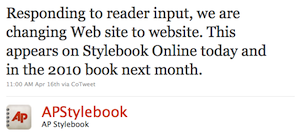This may be a bit “inside baseball,” but it affects to a small degree the text you see in the Chronicle, both in print and online.
Like most newsrooms, the Chronicle follows Associated Press style. That means that we have little books on our desks that contain rules about how we punctuate and spell.
For example, the stylebook tells us that it is AP Style to omit the “Oxford” comma in lists (the comma directly before and or or in a list.
- Not-AP Style — “gray, green, yellow, and blue”
- AP Style — “gray, green, yellow and blue”
The stylebook also tells us when to spell out numbers and how to handle things like percentages, capitalization, business names and sports terms. The book, importantly, also tells us how reporters are to spell certain words and refer to certain events. A few weeks back, for example, AP decreed that the economic downturn was to be referred to as the “Great Recession.”

I mention all of this as background for a couple of new developments in the world of AP Style. This spring, the AP will publish a new version of its stylebook. Already, a couple of publicized changes have made waves.
 First, a big one, AP has decided to change from “Web site” to “website.” It’s a change that has been a long time coming and one that has earned cheers and jeers from journalists around the world.
First, a big one, AP has decided to change from “Web site” to “website.” It’s a change that has been a long time coming and one that has earned cheers and jeers from journalists around the world.
It’s a welcome change, I guess. I always felt somehow exceptional when I wrote Web page, like I was somehow elevated above the common Web-writing folk. No more. At least we get to keep “Web page,” and “e-mail” is still hyphenated, by gum!
The other change has rankled plenty of copyeditors around the country. AP decided to do away with abbreviations for state names in its copy. (Our state AP bureau in Helena confirmed the truth of it, if you don’t believe the blogger.)
For years, the AP has held on to tradition and used archaic abbreviations similar to those suggested by the U.S. Government Printing Office, such as Mich., Fla., Penn., Calif. and Mont. But as the blog linked above pointed out, that could be hurting AP content’s standing in search results since the AP is about the only organization still using those arcane abbreviations.
However, many editors, including some in the Chronicle newsroom, expressed concern over the proposed change. The lack of abbreviations would help make copy easier to understand, but would probably hurt the readability of text in print. Massachusetts and Pennsylvania are long words, and column widths these days are pretty short.
Reacting, I suppose, to criticism of the abbreviation change, the AP decided late last week to postpone its plans. We’ll have to see where things go from here.
This sort of hubbub happens every time the AP announces a new edition of its stylebook is near. I’m sure there will be scandal over proposed changes in next year’s stylebook too.
Here at the Chronicle, we manage to stay above many of these debates. That’s probably because we can only afford to buy new stylebooks about once every five years! 😉